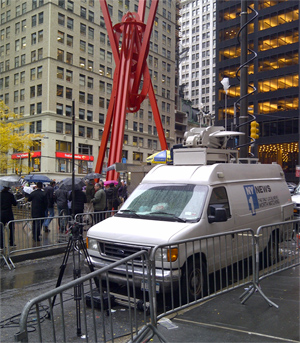Occupy Wall Street Analysis: The Revolution is Indeed Televised

Just about everyone was on camera when the police clashed with Occupy Wall Street protestors at Zuccotti Park Thursday afternoon.
Marking the movement's two month anniversary, protestors planned a "Day of Action" for Thursday, with marches on Wall Street Thursday morning, which saw around 75 arrested, and visits to 16 subway stations around the city, where the protestors vowed to bring their grievances about the distribution of wealth directly to the people of New York City.
It may be a tough sell--reporters following this from Day 1 say public sentiment is ebbing away from the protestors' plight.
Cold rain fell on lower Manhattan at 1 p.m. The western edge of Zuccotti, as it's been for the past two months, was Party Central -- drums, dancing, chanting, and what looked and sounded like, of all things, a French horn.

The eastern edge, along Broadway, was more subdued, the rain, cold and court-mandated sleepless nights apparently sapping the protestors' enthusiasm. A man barked out the principles of Noam Chomsky, a wrecked voice forced through a rolled up OWS-99% placard.
Police, some in riot helmets, clubs in hand, encircled the park. There were thousands, vastly outnumbering the protestors.
The news trucks occupied the southern edge of the park: WNBC, WABC, CNN, Univision and New York 1. Down Broadway a few blocks was a fleet of WCBS vehicles. In between the two makeshift news camps was a white truck with Wiki Leaks emblazoned on it, and a curious crowd around it.
The smarter way to stay on top of broadcasting and cable industry. Sign up below
I saw no reporters doing standups while I was there; either they were grabbing lunch or warming up in the back of the van. The park was relatively quiet, and there wasn't much to report. At least for the next few minutes.
At 1:25, the protestors appeared to mobilize, several dozen of them following a leader. The drums picked up their pace. The chanting got louder, and neared a frenzy. You could feel the excitement level spike.
The police soon followed, marching into the park at a steady, methodical pace. As they entered Zuccotti, one protestor held a sign thanking the police for their protection, and noting how that had not been in the case throughout the Arab Spring.
People whipped out their smartphones.

At 1:40, violence erupted. Once in the park, the police attempted to evacuate it from the middle. Some protestors went without a fight, while others did not. A woman with a WABC flag looked for the best angle. A woman from CNN did the same. One had to think twice about crossing the street and getting much closer to the park, as the police may not have differentiated from protestors and reporters in the heat of the melee.
"Shame! Shame!" chanted the protestors at the cops. "Fascists!" hollered others.
While some local reporters have mentioned the ill will they've gotten from a small minority of protestors, including purposely blocked camera shots, pit bull bites, and one New York journo, WNYW's John Huddy, who a crazed protestor threatened to stab, backpedaling protestors suddenly looked to the reporters as allies.
"Get the truth on camera!" one irate man screamed at a WABC photographer as he retreated from the police foray.
A second protestor had a similar thought a few minutes later, staring up at the photog atop the WABC van. "You getting this?" he hollered in a frenzy. "You're getting this, right?"
In fact, the police were recording this tiny slice of American history as well. At one point, as I looked out to where perhaps 20 police pushed protestors through a barricade and out of the southern edge of the park, I saw five NYPD personnel with miniature video cameras of their own, carefully shooting the protestors.
As the melee went on for about eight minutes, cameras were everywhere. iPhones and Blackberrys and digital cameras, shooting stills and video, to be cued up for social media distribution.
Everyone's a reporter and a director and a star in the show.
Michael Malone is content director at B+C and Multichannel News. He joined B+C in 2005 and has covered network programming, including entertainment, news and sports on broadcast, cable and streaming; and local broadcast television, including writing the "Local News Close-Up" market profiles. He also hosted the podcasts "Busted Pilot" and "Series Business." His journalism has also appeared in The New York Times, The L.A. Times, The Boston Globe and New York magazine.

